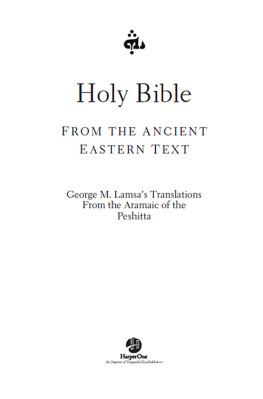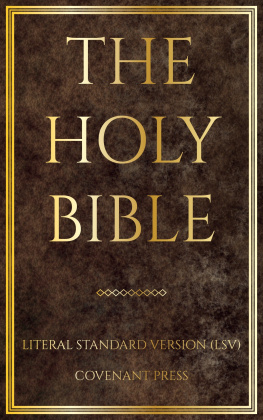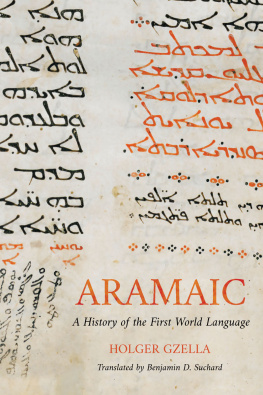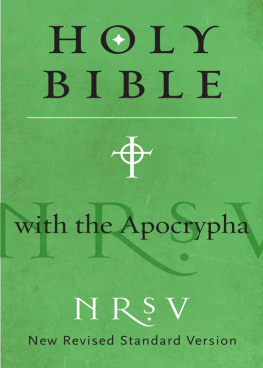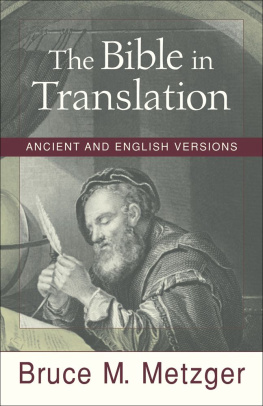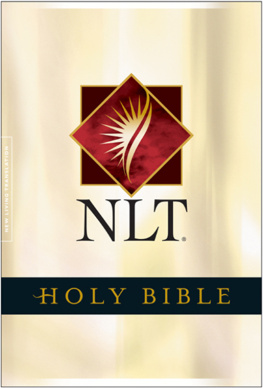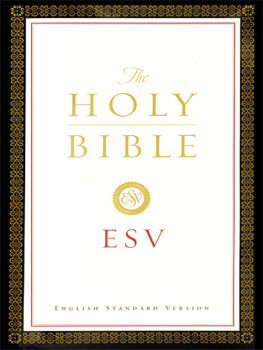Lamsa - Holy Bible: from the ancient eastern text
Here you can read online Lamsa - Holy Bible: from the ancient eastern text full text of the book (entire story) in english for free. Download pdf and epub, get meaning, cover and reviews about this ebook. City: San Francisco, year: 2013;2003, publisher: HarperCollins, genre: Religion. Description of the work, (preface) as well as reviews are available. Best literature library LitArk.com created for fans of good reading and offers a wide selection of genres:
Romance novel
Science fiction
Adventure
Detective
Science
History
Home and family
Prose
Art
Politics
Computer
Non-fiction
Religion
Business
Children
Humor
Choose a favorite category and find really read worthwhile books. Enjoy immersion in the world of imagination, feel the emotions of the characters or learn something new for yourself, make an fascinating discovery.
Holy Bible: from the ancient eastern text: summary, description and annotation
We offer to read an annotation, description, summary or preface (depends on what the author of the book "Holy Bible: from the ancient eastern text" wrote himself). If you haven't found the necessary information about the book — write in the comments, we will try to find it.
This handsome new edition of the authoritative English translation of the Aramaic (Syriac) Old and New Testaments--the language of Jesus--clarifies difficult passages and offers fresh insight on the Bibles message.
Lamsa: author's other books
Who wrote Holy Bible: from the ancient eastern text? Find out the surname, the name of the author of the book and a list of all author's works by series.
Holy Bible: from the ancient eastern text — read online for free the complete book (whole text) full work
Below is the text of the book, divided by pages. System saving the place of the last page read, allows you to conveniently read the book "Holy Bible: from the ancient eastern text" online for free, without having to search again every time where you left off. Put a bookmark, and you can go to the page where you finished reading at any time.
Font size:
Interval:
Bookmark:
The favorable reception accorded the Lamsa translation of the Gospels, later of the New Testament and of the Psalms, has prompted us to publish a complete translation of The Holy Bible from the Peshitta, the authorized Bible of the Church of the East. This translation of the Old and New Testaments into English is based on Peshitta manuscripts which have comprised the accepted Bible of all of those Christians who have used Syriac as their language of prayer and worship for many centuries. It is appropriate that as we have translations based on the Greek Septuagint of the Old Testament and on the Latin Bible of Jerome, so also should there be available to the modern reader that form of the text which was translated anciently into a branch of the Aramaic language which has been used by Christians from earliest times.
In the long history of the Aramaic language, there are three periods of special interest to us. From the sixth to the fourth century before Christ, it was a language of empire extending from the borders of Persia to those of Europe, and down the Nile through the length of Egypt. It was in those days spoken and written by the Jewish people at least equally with Hebrew; and so we have parts of Ezra and Daniel, and one verse in Jeremiah (10:11), that were composed in Aramaic and preserved in that ancient form of the language in the midst of the Hebrew Old Testament.
In the first century, Jesus and his earliest followers certainly spoke Aramaic for the most part, although they also knew Hebrew. Therefore the Gospel message was first preached in the Aramaic of the Jews of Palestine. Modern scholarship tells us that the originals of the Four Gospels and of other parts of the New Testament were written in Greek; this is disputed by the Church of the East and by some noted Western scholars. Regardless of which view one may accept, Aramaic speech is an underlying factor and it is unquestionably true that documents written in Aramaic were drawn on by writers of the New Testament, the basic inspired form of the Christian message.
Aramaic was the language of the Church that spread east, almost from the beginning of Christianity, from Antioch and Jerusalem, beyond the confines of the Roman Empire. This differed from the language of Palestine in choice of words and grammatical forms rather more extensively than does American English from British English and in written form these differences became regular and standardized. The Jews and Christians used the literary dialect of Aramaic that we call Syriac almost at the same time to propagate their translations of the sacred books brought from Palestine and the West, reaching into Syria and Mesopotamia and the nearby mountains, quite early into India, and into China in the course of time. Modern scholarship believes that as happened in other parts of the Church, the earliest copies of the sacred books in Syriac were revised again and again to bring them closer to the standard of the Hebrew and Greek texts from which they were drawn; this view, too, is not accepted by the Church of the East. Under any conditions by the fifth century A.D. the Peshitta version in its present form held the field by universal acclaim.
The fixed stand of the Church of the East with respect to some of the points mentioned above can best be understood by reference to the following letter, which we are authorized to quote, from the Patriarch and Head of that Church:
Patriarchate of the East, Modesto, California, April 5, 1957
With reference to your letter concerning Lamsas translation of the Aramaic Bible, and the originality of the Peshitta text, as the Patriarch and Head of the Holy Apostolic and Catholic Church of the East we wish to state, that the Church of the East received the scriptures from the hands of the blessed Apostles themselves in the Aramaic original, the language spoken by our Lord Jesus Christ himself, and that the Peshitta is the text of the Church of the East which has come down from the Biblical times without any change or revision.
Mar Eshai Shimun
by Grace, Catholicos Patriarch
of the East
From the Mediterranean east into India the Peshitta is still the Bible of preference among Christians, though today nearly all who use it speak Arabic, or one of the tongues of South India. West of the Euphrates, spoken Aramaic as a mother-tongue survives today only in two mountain villages northwest of Damascus, differing as much from the speech of Jesus day as French from its parent Latin. East of the Euphrates, in the Kurdish mountains, and near Lake Urmia, perhaps a hundred thousand people (Christian, Jew and Muslim) speak another form of it, strangely mixed with borrowed words from the various languages of their polyglot neighbors, but still basically akin to the Aramaic (Syriac) of olden times.
George M. Lamsa, B.A., F.R.S.A., the translator of this work is uniquely fitted for the task to which he has devoted the major part of his life. He is an Assyrian and a native of ancient Biblical lands, where he lived until World War I. Until that time, isolated from the rest of Christendom, his people retained Biblical customs and Semitic culture which had perished everywhere else. This background, together with his knowledge of the Aramaic (Syriac) language, has enabled him to recover much of the meaning that has been lost in other translations of the Scriptures.
Manuscripts used in making this translation were the Codex Ambrosianus for the Old Testament and the so-called Mortimer-McCawley manuscript for the New Testament; the former is in the Ambrosian Library at Milan, Italy, and has been identified as fifth century A.D.; the latter was used for our previous translation of the New Testament, of which this edition is a revision, and has been variously identified as sixth or seventh century A.D. Comparisons have been had with Peshitta manuscripts in the Morgan Library, New York, N. Y., with manuscripts in the Freer Collection, Washington, D. C., with the Urumiah edition, and with a manuscript of the Peshitta Old Testament in the British Museum, the oldest dated Biblical manuscript in existence. Our translator states that comparisons show no differences in text between these various manuscripts, and that he has filled in the few missing portions of Chronicles from other authentic Peshitta sources, as noted in his Introduction.
We hope that this translation will be of aid to Bible readers and students in obtaining a more thorough and complete understanding of the Scriptures.
T HE P UBLISHER
North of the Garden of Eden in the basin of the river Tigris, in the mountain fastnesses of what is known today as Kurdistan, there lived an ancient people, the descendants of the Assyrians, the founders of the great Assyrian empire and culture in Bible days, the originators of the alphabet and many sciences which contributed so generously to the Semitic culture from which sprang our Bible. These people, the Assyrians, played an important part in the history of the Near East, of the Bible, and of religion in general.
When Nineveh was destroyed in 612 B.C., many of the princes and noblemen of this once vast empire fled northward into inaccessible mountains where they remained secluded and cut off until the dawn of the twentieth century. Nahum says: Thy shepherds slumber, O king of Assyria: thy nobles shall dwell in the dust: thy people is scattered upon the mountains, and no man gathereth them. Nah. 3:18.
Some descendants of the Assyrians and some of the descendants of the ten tribes who were taken captive by the Assyrian kings in 721 B.C., and settled in Assyria, Babylon, Persia and other places east of the river Euphrates, were among the first converts to Christianity.
When Jesus sent seventy of his disciples to preach the gospel, he instructed them not to go in the way of the Gentiles or into any city of the Samaritans but to go to the lost sheep of the house of Israel, meaning the ten tribes who were lost from the house of Israel. Some of the descendants of these Hebrew tribes are still living in Iraq, Iran, and Turkey, and most of them still converse in Aramaic. Jesus command was carried out. The gospel was preached to the Jews first. Now those who had been dispersed by the persecution which occurred on account of Stephen traveled as far as Phoenicia and even to the land of Cyprus and to Antioch, preaching the word to none but to the Jews only. Acts 11:19.
Font size:
Interval:
Bookmark:
Similar books «Holy Bible: from the ancient eastern text»
Look at similar books to Holy Bible: from the ancient eastern text. We have selected literature similar in name and meaning in the hope of providing readers with more options to find new, interesting, not yet read works.
Discussion, reviews of the book Holy Bible: from the ancient eastern text and just readers' own opinions. Leave your comments, write what you think about the work, its meaning or the main characters. Specify what exactly you liked and what you didn't like, and why you think so.

